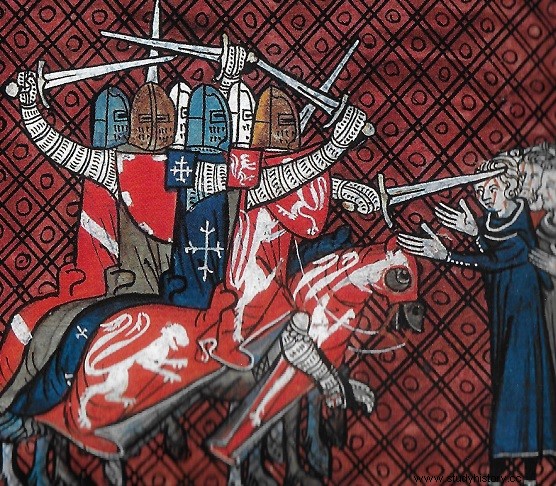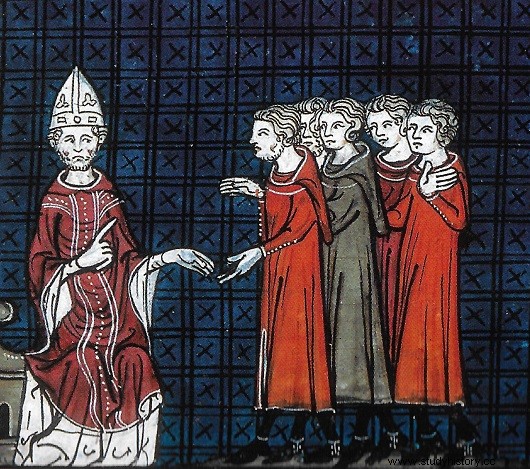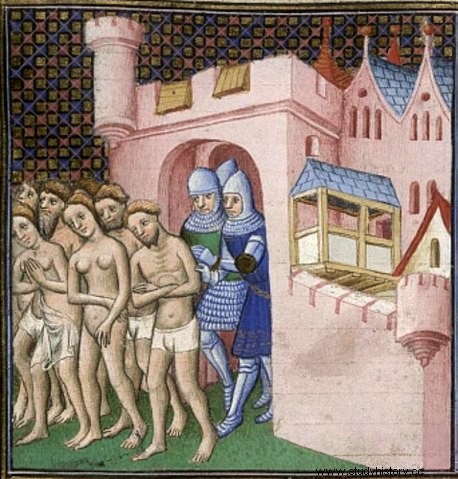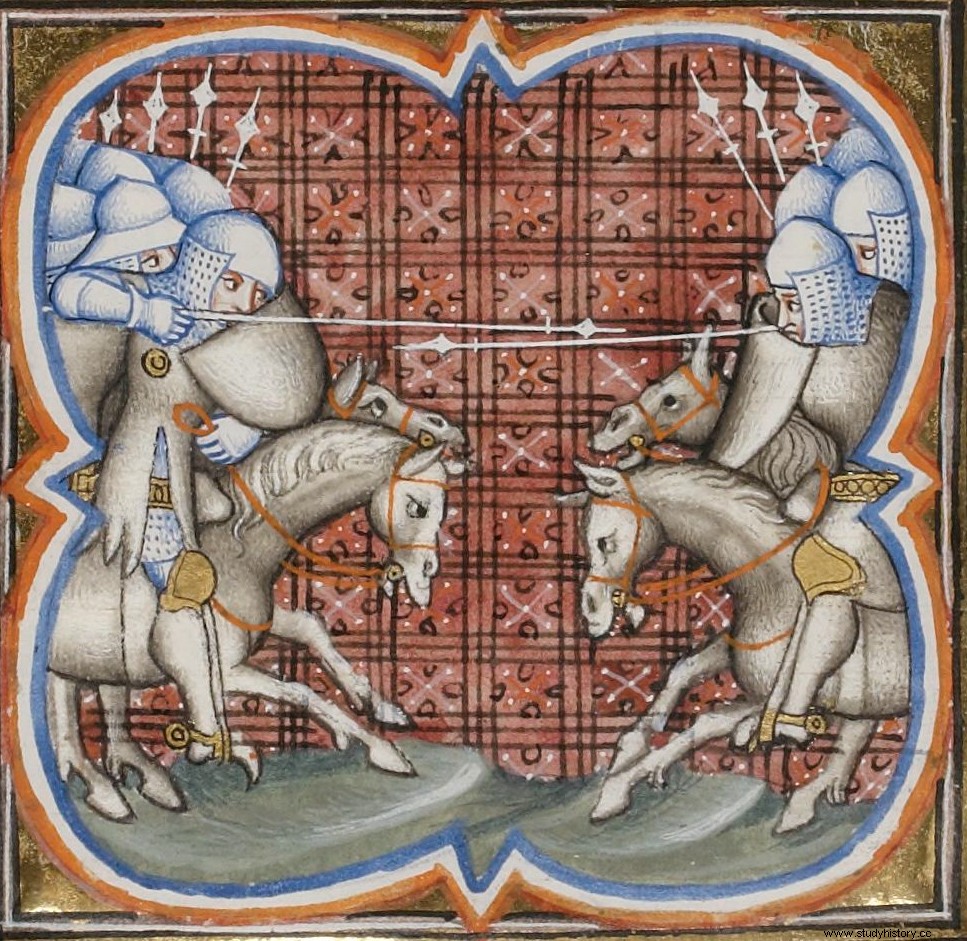 The Albigensian Crusade (1209-1229) is a war started by the papacy to fight the Cathar heresy. Increasingly powerful in Languedoc, the latter considered that the Church governed by the Pope was corrupt and incapable of combating the Evil that reigns over the terrestrial world. Responding to the call of Innocent III, knights from the North of France and adventurers rush to Occitania. Punctuated by sieges, pitched battles, massacres, hangings, burnings and destruction, this crusade against the Albigensians missed its declared goal and was perverted into a pure and simple war of conquest for the benefit of the crown of France:it threw the bases for the annexation of all of Languedoc.
The Albigensian Crusade (1209-1229) is a war started by the papacy to fight the Cathar heresy. Increasingly powerful in Languedoc, the latter considered that the Church governed by the Pope was corrupt and incapable of combating the Evil that reigns over the terrestrial world. Responding to the call of Innocent III, knights from the North of France and adventurers rush to Occitania. Punctuated by sieges, pitched battles, massacres, hangings, burnings and destruction, this crusade against the Albigensians missed its declared goal and was perverted into a pure and simple war of conquest for the benefit of the crown of France:it threw the bases for the annexation of all of Languedoc.
The Albigensian Heresy
As in the first centuries of Christianity, from the 11th century we saw the development of numerous heresies. Many were quickly snuffed out, but a few grew to massive proportions.
The word “heresy” comes from a Greek word that simply means “choice”. The official Church called "heretics", and treated as criminals liable to the death penalty, all Christians who had "chosen" to follow a rule of life different from that of the Catholic clergy and to think, on this or that point of the dogma, other than what the said Church required you to think. In short, non-aligned people, dissidents, all the more dangerous in the eyes of the Holy See because, basing their faith on the New Testament and on it alone, they called themselves Christians, lived as Christians, and even claimed to be the only and true Church of Christ.
So it was with the so-called "Albigensian" heresy (because it spread first and foremost in the region of Aibi). It was inspired by an ancient Persian religion and taught the existence of two opposing principles, Good and Evil, the first being the aura of a good creator God, the second being that of Satan, in whom Christianity saw only a fallen rebel angel. This Albigensian doctrine was accompanied by a very austere morality, but to the observation of which were only compelled the "perfect", or Cathars (that is to say the pure), to whom the consolamentum had been administered, then that the mass of the faithful (believers or "imperfect") received it only at the point of death.
Heresy made rapid progress because the Languedoc clergy led a scandalous existence and compared poorly with the Cathars. To combat it, Pope Innocent III first wanted to resort to preaching alone and encouraged the efforts of Saint Dominic.
Why "Albigensian"?
 In 1179, the Third Lateran Council denounced “the heretics of Gascony, Albigenses, Toulouse country and other places, who are sometimes called Cathars, sometimes Patarins, sometimes publicans or otherwise... ”, Very quickly, one does not really know why, under the pen of the chroniclers as under that of the clerks of the pontifical chancellery, the word “Albigensian” was used to designate, even far from Albi, the heretics established in the 12th and 13th centuries between the Agenais and the Mediterranean, and whom we prefer today to be called “Cathars”, because of the too restricted geographical connotation of the word “Albigensian”.
In 1179, the Third Lateran Council denounced “the heretics of Gascony, Albigenses, Toulouse country and other places, who are sometimes called Cathars, sometimes Patarins, sometimes publicans or otherwise... ”, Very quickly, one does not really know why, under the pen of the chroniclers as under that of the clerks of the pontifical chancellery, the word “Albigensian” was used to designate, even far from Albi, the heretics established in the 12th and 13th centuries between the Agenais and the Mediterranean, and whom we prefer today to be called “Cathars”, because of the too restricted geographical connotation of the word “Albigensian”.
The council of 1179 had appealed, against the Occitan Cathars, to the armed force available to the lords of the country. As the said lords, from the modest squire of the Lauragaise countryside to the counts of Toulouse and Foix, publicly protected the Cathar communities established in towns and villages, and which they even had, often, in their family, one or more “proven heretics” (hereticus perfectus), the appeals of the Church remained a dead letter.
The crusade against the Albigensians
A crusade is a holy war, that is, as far as the medieval West is concerned, a war that is waged in the name of the religion of Christ. This was the case of the expeditions carried out in the Holy Land against the infidels, and which served as a model for that which the Holy See launched against the Occitan Cathars. It is also because they enter the militia Christi, the army of Christ, that those who engage in such a war sew a cross on their coat and are called crusaders.
Elected in 1198, Pope Innocent III decided to immediately set up the military intervention which alone, in his eyes, would settle the Cathar question. But as he found no one in the Occitan country to take up arms, he was forced to call in a foreign army:he then had the crusade preached throughout Christian Europe, especially in France and neighboring countries. A huge army, essentially French, then set out in the spring of 1209.
The fact that in twenty years of war the Roman Church did not manage to get the better of Occitan Catharism, but that the crown of France derived major benefits from this operation by annexing half of the county of Toulouse, what would later be called lower Languedoc, and by giving itself the legal means to annex the other half - upper Languedoc - in the medium term, it has often been asked whether the “holy war” had not been a false pretext and if it had not been, in fact, the mask of the French conquest.
Now we know, thanks to the correspondence he exchanged with Innocent III, that King Philip Augustus did not want this crusade, that he refused, despite the supplications of the Pope, to take the lead, and that he even forbade his son, the future Louis VIII, and his great barons to cross paths.
But the assassination at Saint-Gilles, in January 1208, of the papal legate Pierre de Castelnau, removed the last obstacles. Faced with this sacrilegious act, which the Church imputed to the Count of Toulouse, Raymond VI, the pressure from the high clergy of France was such that Philippe Auguste had to consent to his vassals taking the cross - while refusing to take it himself. and involve his son in the operation. If he could not prevent the crusade, at least the king of France delayed it for ten years...
The first successes of the Crusaders
Innocent III “exposed as a prey” the lands of the Occitan princes suspected of tolerating the Cathars on their domains, first and foremost the Count of Toulouse and his nephew the young Raymond-Roger Trencavel , viscount of Béziers, Carcassonne, Albi and Razès. He offered their lands and their titles “to any good Catholic who will want to seize them”.
 July 1209:Béziers refuses to open its gates to the Crusaders who, through the Rhone valley, have swept over Languedoc. So they attack. Carcassonne is then besieged, Trencavel is treacherously captured and assassinated. Its titles and its domains are given by the papal legate, the abbot of Cîteaux Arnaud Amaury, to a lord of Île-de-France, Simon de Montfort, who becomes the military leader of the invading army. /P>
July 1209:Béziers refuses to open its gates to the Crusaders who, through the Rhone valley, have swept over Languedoc. So they attack. Carcassonne is then besieged, Trencavel is treacherously captured and assassinated. Its titles and its domains are given by the papal legate, the abbot of Cîteaux Arnaud Amaury, to a lord of Île-de-France, Simon de Montfort, who becomes the military leader of the invading army. /P>
The Church triumphs. But that does not suit the suzerain of Carcassonne:the King of Aragon, Peter II, a Catholic sovereign if ever there was one, since he was himself a vassal of the Holy See! The establishment in the Pays d'Oc of a French lord, at the head of a whole French chivalry to whom he will distribute the conquered fiefs, constitutes a serious threat to the crown of Aragon:it is the end of the geopolitical balance that it has established in the northern Pyrenean area, since Raymond VI and his son each married a sister of the king. The latter even signed in 1204 with the Count of Toulouse a treaty of alliance “against every man in the world”. But, occupied by the war that Aragon and Castile are waging against the Muslims of Spain, Peter II cannot intervene in Languedoc.
So, for nine years, Montfort rode across the country. He massacres, ravages, plunders - even the abbey of Moissac! -, he sets up huge collective pyres for the Cathars he captures. He distributes the seigneuries to his companions. He conquered the Albigeois, the Agenais, the Quercy, the Rouergue. He brings war to lands where there have never been heretics:Comminges, Bigorre, Béarn, Provence...
The Occitan and Aragonese resistance
 In July 1212, the victory of Las Navas de Tolosa over the Almohades finally left a free hand for the king of Aragón. He flies to the aid of the Occitans, and is recognized, in Toulouse, suzerain and protector of all the countries threatened by the crusade. Unfortunately for the latter, for lack of having had a single command and of having adopted effective tactics, the grand coalition gathering around the Catalans and the Aragonese the counts of Toulouse, Comminges and Foix, was routed in the plain. de Muret, September 12, 1213, by the heavy cavalry of Simon de Montfort. Pierre II even found death in the battle... Montfort victorious, the Holy See proclaims him Count of Toulouse in place of Raymond VI, deposed and condemned to exile; but the conqueror died in 1218, his head shattered by a catapult ball, while besieging rebellious Toulouse.
In July 1212, the victory of Las Navas de Tolosa over the Almohades finally left a free hand for the king of Aragón. He flies to the aid of the Occitans, and is recognized, in Toulouse, suzerain and protector of all the countries threatened by the crusade. Unfortunately for the latter, for lack of having had a single command and of having adopted effective tactics, the grand coalition gathering around the Catalans and the Aragonese the counts of Toulouse, Comminges and Foix, was routed in the plain. de Muret, September 12, 1213, by the heavy cavalry of Simon de Montfort. Pierre II even found death in the battle... Montfort victorious, the Holy See proclaims him Count of Toulouse in place of Raymond VI, deposed and condemned to exile; but the conqueror died in 1218, his head shattered by a catapult ball, while besieging rebellious Toulouse.
His son Amaury succeeded him... Valiant, but too young and inexperienced, he could not stand up to the war of liberation led by Raymond VI and his son Raymond VII, by the Count of Foix, and by all their vassals. He lost one by one the immense conquests of his father and, besieged in Carcassonne in January 1224, he capitulated and returned to France with the last square of his faithful. The Montfort Crusade is defeated.
The end of the Albigensian crusade
The Cathars who escaped the stakes resettle in the liberated country. So the Holy See launched a second crusade in 1226, led this time by the new King of France in person, Louis VIII. He understood all the benefits that the Crown had to derive from the operation...
The country, battered by seventeen years of war, is collapsing. Raymond VII was forced to sign the Treaty of Paris in 1229 which annexed to the royal domain, in addition to the former Viscounty of Trencavel, half of his States:all his domains in lower Languedoc opening onto the Mediterranean. His daughter Jeanne is forcibly married to a brother of Louis IX. The next Count of Toulouse will therefore be a Capetian. And the treaty provides that on his death, if he has no children, the whole earldom will revert to the king...
That was what happened in 1271. That's why Languedoc has been French ever since. As for heresy, twenty years of crusade having solved nothing at all, the Holy See soon set up a new means of repression:the Inquisition... But it took almost a century for it to come. at the end of the extraordinary clandestine resistance of the forbidden religion:the last perfect Cathar, Guilhem Bélibaste, was not captured and burned until 1321...
Bibliography
- The Albigensian Crusade, the fight against the Cathars, by Francois de Lannoy. West-France, 2013.
- The crusade against the Albigensians and the union of Languedoc with France, 1209-1249. Perrin, 1999.
